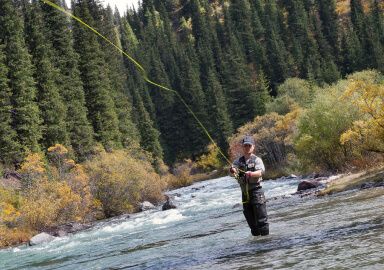Crayfish
Crayfish are mostly small-sized freshwater crustaceans that are fun to catch and can provide excellent and tasty meals.
View 2 listings
2
listings
–
price starting from
2
countries
–
to the nearest trip
Where and When?
There are four families of true crayfish, three in the northern hemisphere and the fourth, the Parastacidae, distributed along South America, and Australasia. The south-eastern of the USA is the world centre for crayfish diversity with over 330 species, whereas only several species exist in Europe and Asia.
Crayfish generally live in shallow margins of rivers and lakes, often under stones or in burrows. Crayfish prefer muddy bottoms, for feeding, and need water with high levels of calcium. That means acid rains and low pH levels can spell extinction for crayfish. Most species are more active after dark, but can also be seen moving around in daylight. Crayfish feed throughout the year but the warmer months are generally times of greater movement and feeding.
About Crayfish
Crayfish are decapod (ten-legged) crustaceans that live in fresh and brackish waters, although the name is often applied to lobsters in Australia and South Africa. Crayfish come in different forms and sizes, but all have separate “head” and body sections with “legs” and “pincers” on the former and thin “paddles” on the latter. Colour varies from almost black to grey or green. Most crayfish are smallish, around 250 g. (8.8 oz.), but the largest, the Tasmanian giant crayfish, can attain 5 kg. (11 lbs).
Crayfish pick most of their food from the substrate, and much of it consists of “detritus”, a dark material often coating pond and dam bottoms. Some crayfish, however, catch insects and even fish, but this occasional predation usually only supplements the regular diet of dead animal and plant matter.
Crayfish live around the shallower margins of lakes, dams and slow-moving rivers, often creating their own burrows. Most do not undertake large migrations, usually staying close to home all their lives. The sexes are separate, and eggs are usually retained by the female. Young animals cling to their mother’s underside until fully formed, then they leave and start their own lives.
How to Catch?
Catching crayfish can be a fun family activity that produces very special foods or even pets. In many states of the USA one needs to have a licence for crayfishing, but then they may be caught all year, in any quantities by a wide variety of methods. Recreational crayfishing can be carried out by pole, trap, net or hand.
Pole fishing is very simple, and the most basic equipment can suffice as there will be no mad runs and leaping out of the water. In essence, a length of line or string, about 1.5 m (59 in.) long, is attached to the end of the pole and some bait tied or hooked onto the lower end. The bait is lowered into a likely looking spot until a crayfish grabs it. The bait and crayfish is then gently brought towards the shore into a hand, net or bucket. Good baits are fish, fatty meats or hot dogs.
Crayfish can be caught with the help of valved traps, into which crayfish can crawl but can’t escape. A simple piece of net, fixed to a frame, with a piece of rotting meat inside can also work - you leave it there for a while, and then carefully lift it out of the water together with the crayfish feasting on the bait.
Perhaps the most fun method of crayfishing is hand capture. You simply check under stones and burrows and grab the crayfish you find, the risk of crayfish attacking your fingers with their pincers providing for the thrill. A pro tip: most crayfish burrows are U-shaped, with an escape opening at the rear. Locate the escape exit, hold your hand over it, and tickle the crayfish’s whiskers that are sticking out of the burrow. The crayfish will usually shoot backwards right into your hand.




